
The Mountain Time Zone of North America keeps time by subtracting seven hours from Coordinated Universal Time (UTC) when standard time (UTC−07:00) is in effect, and by subtracting six hours during daylight saving time (UTC−06:00). The clock time in this zone is based on the mean solar time at the 105th meridian west of the Greenwich Observatory. In the United States, the exact specification for the location of time zones and the dividing lines between zones is set forth in the Code of Federal Regulations at 49 CFR 71.

Raphia is a genus of moths of the family Noctuidae. It is the only genus under subfamily Raphiinae. They occur in southern Europe, temperate Asia, and North America.
Stiria is a genus of moths of the family Noctuidae. The genus was erected by Augustus Radcliffe Grote in 1874.

Acronicta sperata, the hopeful dagger moth, is a moth of the family Noctuidae. The species was first described by Augustus Radcliffe Grote in 1873. It is found in North America from New Brunswick west to the Alberta foothills, south to the District of Columbia, Missouri and in the mountains to Colorado.

Catocala junctura, the joined underwing or Stretch's underwing, is a moth in the family Erebidae. The species was first described by Francis Walker in 1858. It is found throughout temperate North America, ranging from New York and Pennsylvania west to Montana, Colorado, Oklahoma, Arizona, and into Texas, and north to southern Illinois, extreme southern Alberta and Saskatchewan; it has also been recorded west of the Rocky Mountains from California and south-eastern British Columbia. It is typically found near water, where the food plants of its caterpillar larvae grow plentifully.

Acronicta mansueta, the gentle dagger moth, is a moth of the family Noctuidae. The species was first described by Smith in 1897. It was considered a synonym of Acronicta falcula, but was reinstated as a valid species in 2011. It is widespread in western North America, from southern Saskatchewan west to southern British Columbia, and south to at least Colorado and California.
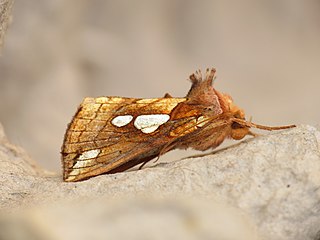
Plusia putnami, the Lempke's gold spot or Putnam's looper moth, is a species of moth of the family Noctuidae. It is found in the Palearctic realm, from Japan and eastern Siberia to Fennoscandia, Great Britain, and France. In North America, it ranges from Newfoundland and Labrador to central Alaska and the interior of British Columbia, south to Pennsylvania, Washington, north-eastern California, and in the Rocky Mountains to Utah and Colorado.
Euxoa campestris, the flat dart, is a moth of the family Noctuidae. The species was first described by Augustus Radcliffe Grote in 1875. It is found in North America from Newfoundland to Alaska, south to New England and southern Canada from southern Quebec west to British Columbia. In the west it is distributed southward in the Rocky Mountains to southern New Mexico, east-central Arizona, and central Utah. In the east it occurs in the Appalachians in eastern Kentucky and in western North Carolina.
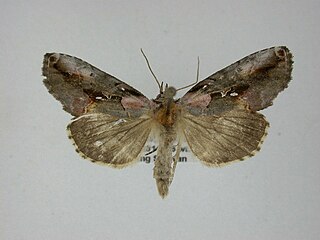
Eosphoropteryx thyatyroides, the pink-patched looper moth or pink-tinted beauty, is a moth of the family Noctuidae. The species was first described by Achille Guenée in 1852. In North America it is found from Nova Scotia and northern Ontario south to Minnesota, Michigan, Ohio and along the Appalachians from Maine to eastern Tennessee and western North Carolina; and to the west, it occurs from central Alberta and southern British Columbia, south in the Cascades to southern Oregon, and in the Rocky Mountains to northern Idaho.
Euxoa bochus is a moth of the family Noctuidae first described by Herbert Knowles Morrison in 1874. It is found in western North America, from Vancouver Island, south to southern Utah and northern New Mexico, east to central Colorado, Wyoming and the Cypress Hills area of south-western Saskatchewan. It is also present in Manitoba and British Columbia.
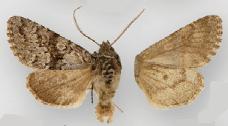
Lasionycta subfuscula is a moth of the family Noctuidae. It is found from south-western British Columbia and south-western Alberta south to southern Oregon in the west and to southern Colorado and Utah in the Rocky Mountains.

Lasionycta impingens is a moth of the family Noctuidae. It occurs from southern Yukon to Colorado.
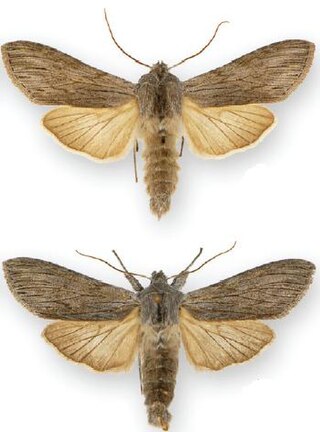
Cucullia intermedia, the dusky hooded owlet, intermediate cucullia, goldenrod cutworm or intermediate hooded owlet, is a moth of the family Noctuidae. The species was first described by Adolph Speyer in 1870. It is found from coast to coast across southern Canada and the northern United States, south in the west to California and to Pennsylvania in the east. In the Rocky Mountains it is found south to the White Mountains in east-central Arizona and occurs commonly in Utah, Colorado and north-eastern Nevada.

Euxoa edictalis is a moth of the family Noctuidae first described by Smith in 1893. It is found in North America from south central Alberta and east-central Montana, west to south-central British Columbia, south to central California, southern Nevada, central Utah and western Colorado.

The pale enargia or aspen twoleaf tier is a moth of the family Noctuidae. It has a boreal-transcontinental distribution, occurring across the Canadian boreal plain and then southward through the western cordillera at higher elevations, where it is presumably limited by the availability of trembling aspen and possibly other poplars. Records range from northernmost British Columbia and south-western Northwest Territories east to New Brunswick. It has also been reported from Nova Scotia, Ohio and New York. In the western United States it is known from western Montana, Idaho, Washington, Oregon, Nevada, Utah, Wyoming, western Colorado, New Mexico, and Arizona. There are no records from the Rocky Mountain front ranges of Colorado, where it would be expected to be widespread if there is a continuous distribution southward into New Mexico and Arizona. The populations from west of the Rocky Mountains south to New Mexico and Arizona may represent a distinct species.

Bryolymnia semifascia, the half-banded bryolymnia, is a moth of the family Noctuidae. The species was first described by John Bernhardt Smith in 1900. It is found in the US from northern Colorado and southern Utah southward to south-eastern Arizona and south-central New Mexico.
Apantesis f-pallida is a moth of the family Erebidae. It was described by Strecker in 1878. It is found from south-eastern Utah and Colorado south to eastern Arizona, New Mexico and eastern Texas. It has also been recorded from west-central Nevada, and probably also occurs in Mexico.

Apantesis phyllira, the phyllira tiger moth, is a moth of the family Erebidae. It was described by Dru Drury in 1773. It is found in North America from Quebec and New England south to Florida and west to Texas, Colorado and Alberta. The habitat consists of dry, open woodland and grassland. The species is listed as endangered in Connecticut.
Apantesis williamsii, or Williams' tiger moth, is a moth of the family Erebidae. It was described by Charles R. Dodge in 1871. It is found in North America from the Northwest Territories east to the northern Great Lakes region, New Brunswick and New England. It also occurs throughout the northern Great Plains, south at higher elevations to Arizona and New Mexico, west to south-eastern British Columbia and eastern California.
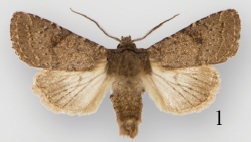
Protorthodes curtica is a moth in the family Noctuidae first described by Smith in 1890. It is found in North America from the interior of southern British Columbia southward in the West Coast states, mainly to the east of the Cascades and Coastal ranges, to southern California. It occurs in the Rocky Mountains in Idaho and Montana and in the Ruby Mountains of Nevada. The habitat consists of dry forested areas.









